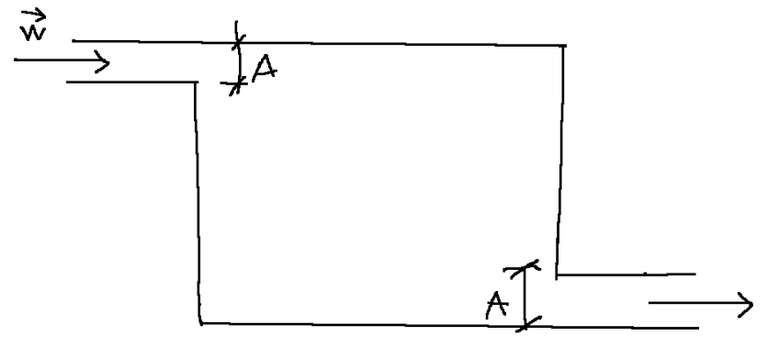
~~~ La versione in italiano inizia subito dopo la versione in inglese ~~~
ENGLISH
25-01-2024 - Physics - continuity equation [EN]-[IT]
The continuity equation
The continuity equation in physics is an equation that expresses in local form the conservation law for a generic physical quantity using the flow of the quantity through a closed surface.
Let's take the following figure as an example to talk about the mass continuity equation.

The mass flow rate along the stationary currents remains constant.
Let us remember that in the system conventionally the convective flows will be considered positive if they leave the system and negative if they enter.
mass flow rate
We will call the following quantity mass flow rate:
𝐦̇ = 𝛒·𝐰·𝐀
Where:
𝐦̇ = mass flow rate (Kg/sec])
𝛒 = fluid density (kg/m3)
𝐰 = average velocity of the fluid in a direction perpendicular to area A (m/s)
𝐀 = section surface (m2)
volumetric flow rate
We will call the following quantity volumetric flow rate:
𝐕̇ = 𝐰·𝐀
Where:
𝐕̇ = volumetric flow rate (m3/sec)
𝐰 = fluid flow velocity perpendicular to the area (m/s)
𝐀 = section surface (m2)
Equality resulting
From what we wrote before the following equality derives
𝐦̇ = 𝛒𝐕̇
Where
𝐦̇ = mass flow rate
𝛒 = fluid density (kg/m3)
𝐕̇ = volumetric flow rate (m3 / s)
Conclusions
For liquids, more precisely for water, the density of the fluid will be for example, 𝛒 = 1,000 Kg/m3 = const. Between the mass flow rate and the volumetric flow rate, the most used in general is the mass flow rate, but for liquids the volumetric flow rate is also used.
Request
Have you heard more about mass flow rate or volumetric flow rate?

25-01-2024 - Fisica - equazione di continuità [EN]-[IT]
L’equazione di continuità
L’equazione di continuità in fisica è un'equazione che esprime in forma locale la legge di conservazione per una generica grandezza fisica utilizzando il flusso della grandezza attraverso una superficie chiusa.
Prendiamo come esempio la figura seguente per parlare dell’equazione della continuità di massa.

La portata massica lungo le correnti stazionarie si mantiene costante.
Ricordiamo che nel sistema convenzionalmente i flussi convettivi si considereranno positivi se escono dal sistema e negativi se entrano.
portata massica
Chiameremo portata massica la seguente grandezza:
𝐦̇ = 𝛒·𝐰·𝐀
Dove:
𝐦̇ = portata massica (Kg/sec])
𝛒 = densità del fluido (kg/m3)
𝐰 = velocità media del fluido in direzione perpendicolare all’area A (m/s)
𝐀 = superficie della sezione (m2)
portata volumetrica
Chiameremo portata volumetrica la seguente grandezza:
𝐕̇ = 𝐰·𝐀
Dove:
𝐕̇ = portata volumetrica (m3/sec)
𝐰 = velocità del flusso di fluido perpendicolare all’area (m/s)
𝐀 = superficie della sezione (m2)
Uguaglianza derivante
Da ciò che abbiamo scritto prima deriva la seguente uguaglianza
𝐦̇ = 𝛒𝐕̇
Dove
𝐦̇ = portata massica
𝛒 = densità del fluido (kg/m3)
𝐕̇ = portata volumetrica (m3 / s)
Conclusioni
Per i liquidi, più precisamente per l’acqua, la densità del fluido sarà ad esempio, 𝛒 = 1.000 Kg/m3 = cost. Tra la portata massica e quella volumetrica, la più usata in generale è quella massica, ma per i liquidi si usa anche la volumetrica.
Domanda
Avete sentito parlare di più della portata massica o della portata volumetrica?
THE END




